This was published 1 year ago
Travel chaos: How to find lost luggage, what to do if your flight is cancelled and other travel tips
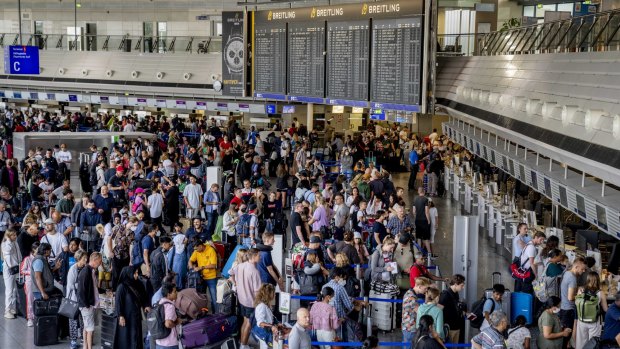
International travel is a mess at present, mostly due to global staffing shortages.Credit: AP
Airline travel is in a mess. The chances of your flight being delayed or cancelled or having your checked baggage go astray have never been greater and it's happening all around the globe.
The root of the problem is the same everywhere - staffing. Airlines and airports are having a tough time replacing the thousands of staff lost during the pandemic.
From pilots to cabin crew, baggage handlers, call-centre staff, security personnel and the chefs who prepare and pack inflight meals, thousands of employees were stood down, took early retirement or left to find other jobs. And staff absences due to COVID-19 also continue to have an impact.
For the traveller, it's cold comfort if your luggage bound for Heathrow ends up in Houston or your flight is delayed or, worse, cancelled. Keeping your travel plans intact, and for that matter your wits, is now tougher than ever. Here's Traveller on Sunday's special survival guide for air travel here and around the world.
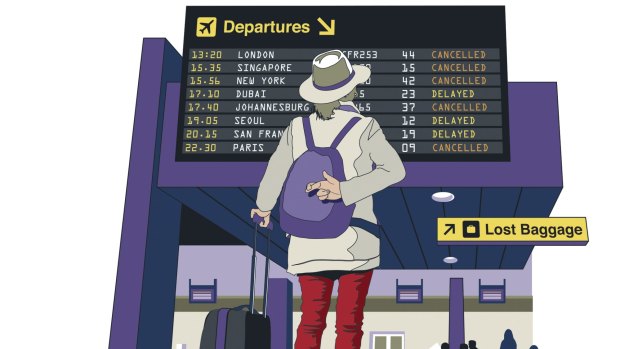
Credit: Illustration: Jamie Brown
BEFORE YOU BOOK
IS THERE A BEST TIME OF DAY TO FLY?
Early morning flights are the most dependable. Later in the day is when the glitches happen. A technical problem, staff calling in sick – anything that causes an aircraft to delay its scheduled departure has a knock-on effect for the rest of that day.
Airlines can't just pull another aircraft into service and as for staff, they're at full stretch, with no backup crews who can take their place. Adding to the problem, regulations mean flight crew are restricted in the number of hours they can work.
Once on duty the clock is ticking. If they're waiting for a late arriving aircraft and their rostered flight would put them over their time limit, they're not working that flight.
SHOULD I BUILD MORE TIME INTO MY ITINERARY TO ALLOW FOR PROBLEMS?
Flying off for a cruise, a wedding, or you're about to sign on the dotted line for that flowery retreat you've just bought in France?
Get to your destination the day before. Better still, two days before. If something goes wrong and your departure is delayed or if your luggage fails to arrive on your flight, you've got some slack in your itinerary.
On that same note, a non-stop flight is preferable since a stopover opens the possibility for problems to arise. This doesn't always apply, however. A Qantas flight recently flew non-stop from Darwin to London without a single piece of passengers' checked luggage on board. Bags took up to six days to arrive but prudent passengers with time on their hands were at least able to shop for the essentials. Note too, a direct flight may include a stop between origin and destination. A non-stop flight between the two is exactly that. Even airlines and travel agents confuse the two.
DO I REALLY NEED TRAVEL INSURANCE FOR A DOMESTIC FLIGHT?
In these uncertain times, travel insurance is more important than ever (and you absolutely do need it for any overseas travel).
Even for domestic flights, travel insurance is the way to go. Check your policy's product disclosure statement to make sure you're covered for extra expenses due to a delayed flight and reimbursement for the cost of new clothing and toiletries if your checked luggage fails to arrive.
If you travel within Australia more than twice in a year, an annual multi-trip policy could work out cheaper than taking out travel insurance on each trip, and you've bought yourself peace of mind.
SHOULD I BOOK DIRECTLY WITH THE AIRLINE OR AN ONLINE TRAVEL AGENT?
Those deals offered by online travel agents (OTAs) are hard to resist. Chances are you'll fly for less than booking directly through the airline operating the service but if anything goes wrong you may regret it.
The OTA is a third party and that adds another layer of complexity. If your flight is cancelled by the airline and you need to get a refund or credit, you'll be dealing with your OTA rather than the airline, and their customer support is often slow and frustrating (then again, airline customer support, or the lack of it, is in crisis).
Even if you manage to get a refund, an OTA may pocket a slice as a cancellation refund fee. If the deal from an OTA is just too good – and they do offer advantages such as multi-airline itineraries - you're better off with one of the larger OTAs such as Expedia, Skyscanner or booking.com
AT THE AIRPORT
I WANT TO TRAVEL WITH CARRY-ON ONLY, IS THERE A WAY AROUND THE WEIGHT LIMIT?
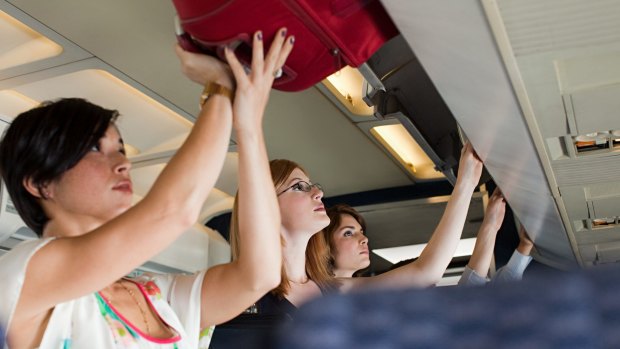
Credit: iStock
The chances of your checked baggage not showing up on the baggage carousel have never been greater (sorry for the bad news).
A recent news report claimed that at Sydney's domestic airport, one in 10 checked bags is not making its designated flight and social media is aflame with passenger complaints about delayed or lost luggage.
Travelling with just carry-ons is the smart way to go, but anything more than a weekend away and I find it tough keeping within the seven-10 kilogram maximum that Australian airlines allow for carry-ons. Jetstar allows you to buy an extra seven kilograms of carry-ons, and 14 kilograms is a decent allowance. One way to bulk up your carry-ons without breaking the seven kilogram limit is to stash your pockets (well, these are desperate times).
I have a showerproof jacket that comes with me every time I fly and it's got lots of pockets. I can stuff those with some of the weightier items I want to take along, freeing up my carry-on case for the more bulky, less heavy items such as clothing.
The weight of the empty jacket is under one kilogram, fully loaded it's around five kilograms, so I'm getting 11 kilograms total carry-ons (or 14 kilograms if I'm aboard the big red 'roo since the Qantas carry-on limit is 10 kilograms).
If you're flying with a checked bag, pack toiletries, essential medications, a change of clothes, fresh underwear, chargers to keep your devices alive in your carry-ons and whatever it takes to get you through a day or two should you and your baggage be (temporarily, we hope) parted.
HOW LONG SHOULD I ARRIVE BEFORE MY DOMESTIC OR INTERNATIONAL FLIGHT?
Airlines are overbooking flights. It's common practice since they want to fly their aircraft full and the assumption is there will always be one or two no-shows. For the airlines, it's better to have every seat occupied and put up with a few moans from the dispossessed than to risk leaving seats empty.
There's a pecking order and passengers who show up late at the check-in desk are the obvious candidates for the boot. Also, those who check in early are more likely to get a better seat.
Check-in for Qantas domestic services closes 30 minutes before flight time, for international flights it's 90 minutes. For Qatar Airways check-in closes 60 minutes before departure while for Singapore Airlines flights departing from Changi it's 40 minutes.
Most international airlines advise arriving at the airport three hours pre-flight. For domestic flights 60 minutes is fine but during peak periods, such as the start or end of school holidays, add another hour.
WHAT IF MY FLIGHT IS CANCELLED?
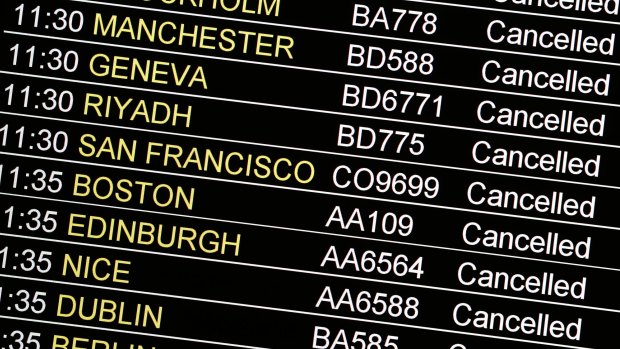
Credit: Alamy
It all depends on where it happens. If Qantas cancels your flight the airline will offer various options, which may be a credit for a future flight, an alternative flight to the same destination or a refund. In the US, your airline should rebook you on the next available flight.
You can also request a full refund but the airline is not required to provide you with a hotel room or food vouchers nor any compensation if the delay causes you to miss an important event such as a wedding or a cruise.
The most generous cancellation terms are for flights within the European Union, or either arriving at or departing from an EU airport, unless it was a flight from the UK operator by a non-EU carrier. If you were notified of a flight cancellation less than 14 days in advance, compensation can be anything from €250 to €600. You need to send your claim to the airline using either the airline's complaint form or the EU air passenger rights form (transport.ec.europa.eu). There are several agencies that will handle your claim for a fee and this is often an easier course.
ONCE YOU'VE LANDED
WHAT DO I DO IF MY LUGGAGE GOES MISSING?
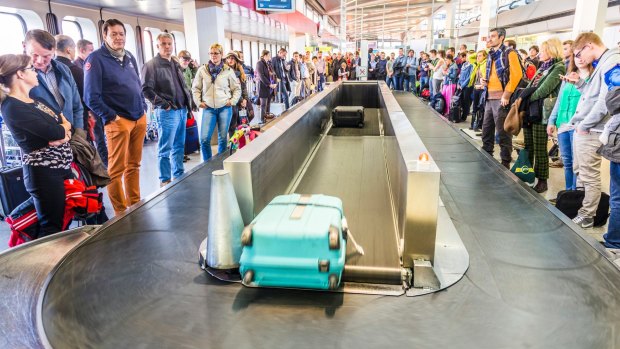
Credit: iStock
If your checked baggage hasn't appeared on the luggage carousel, head for the baggage claim office and lodge a "Property Irregularity Report" with the carrier operating your final flight.
The report will ask for a description of your luggage and if you thought to snap an image on your phone at the check-in desk so much the better. You'll be given a reference number for follow-up calls.
Ask if there is any provision for a cash payment to purchase small necessities such as toiletries. It's not much, usually less than $100, but airlines will never tell you you're entitled to it, you have to ask.
Your airline regards any checked luggage that is not delivered within 21 days as delayed rather than lost. Within that period you need to submit a baggage claim form, available on your airline's website.
WHAT ARE MY RIGHTS IF MY BAGGAGE CAN'T BE FOUND?
If your baggage has not been located within 21 days your airline may deem it lost. For the loss of checked luggage on an Australian domestic flight, you're entitled to compensation under the Civil Aviation (Carriers' Liability) Act 1959, to a maximum of $3000.
On an international flight, the Montreal Convention 1999 sets the carrier's liability at a maximum 1288 Special Drawing Rights (SDR) currently worth around $2500. If the value of lost items is greater, you need to look at your travel insurance policy.
The airline is responsible for locating and delivering delayed baggage to you at the address specified in your report.
However if you've taken an international flight you might have shifted location by the time your luggage is found, therefore you need to stay on top of the situation by calling your airline. In a worst-case scenario, the missing baggage may be delivered to the nearest airport and you may have to make your way there to collect it.
If your bag is delayed for more than a couple of days and prospects for a swift reunion are fading, you'll probably need a shopping expedition.
Get printed receipts for all the merchandise you buy and keep emails and other evidence to prove that your bag is delayed, you'll need it when you make a claim for reimbursement against your travel insurance policy.
WILL A LUGGAGE TRACKER HELP LOCATE MY BAG?
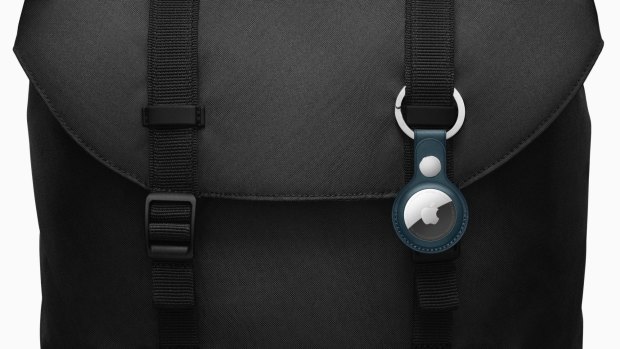
There are several smart luggage trackers on the market. Most work either by global system mobile communications (GSM), the system your mobile phone uses, or by global positioning system (GPS) technology.
The accuracy of GSM trackers is quite low but they will tell you the airport where your bag is sitting, which is probably as much as you need to know. The tracker needs to connect with a local mobile network which means you need to subscribe to the manufacturer's service, usually for a monthly or annual fee.
Some have a maximum of 48 hours' battery life, which is pretty useless for the sort of long-distance routes Australians typically fly. GPS trackers are more accurate but if your bag is sitting in a cargo area somewhere it may not connect with GPS satellites.
The bottom line, all being well, is a luggage tracker should tell you where your bag is but the airline responsible probably knows that. It's not going to speed up the delivery of your bag. That's up to the airline and whatever courier service they may use.
FIVE CLASSIC TIPS FOR EVERY FLIGHT
EXIT STRATEGY
Exit row seats are a gift for long-legged flyers in economy class and many airlines sell them at a premium price but on a twin-aisle aircraft those seats are most likely to be next to the bassinets and allocated to families with toddlers who are not always placid.
DIVIDE AND CONQUER
Travelling as a couple? Even checking in together it can happen that one case will arrive and the other won't. Instead of packing all your own luggage in separate cases, put half your gear in your partner's case and half of theirs in yours. Packing cubes make this simple. If one arrives and the other doesn't, you can scrape by for a few days at least.
MAKE A MOVE
It's vital to get up, stretch and move around at regular intervals on a long flight, and you're much more likely to exercise if you're in an aisle seat. Lack of exercise can result in blood clots, and passengers in window seats have a higher incidence of deep-vein thrombosis.
INCREMENTAL AS ANYTHING
It's long been known that diet plays a role in jet lag, and scientists at the Division of Sleep Medicine at Harvard Medical School suggest shifting mealtimes and bedtime in small increments closer to the schedule at your destination for a week before departure. A tough call if there's a 10-hour time difference, but even a partial switch may help.
FORWARD PLANNING
If the cabin looks full when you board, stash your carry-on case in the overhead lockers at the forward end. Nothing worse than finding all the lockers full when you get to your seat, and those further forward are usually the last to fill. Just make sure you take whatever inflight necessities you need to your allocated seat.
Sign up for the Traveller newsletter
The latest travel news, tips and inspiration delivered to your inbox. Sign up now.